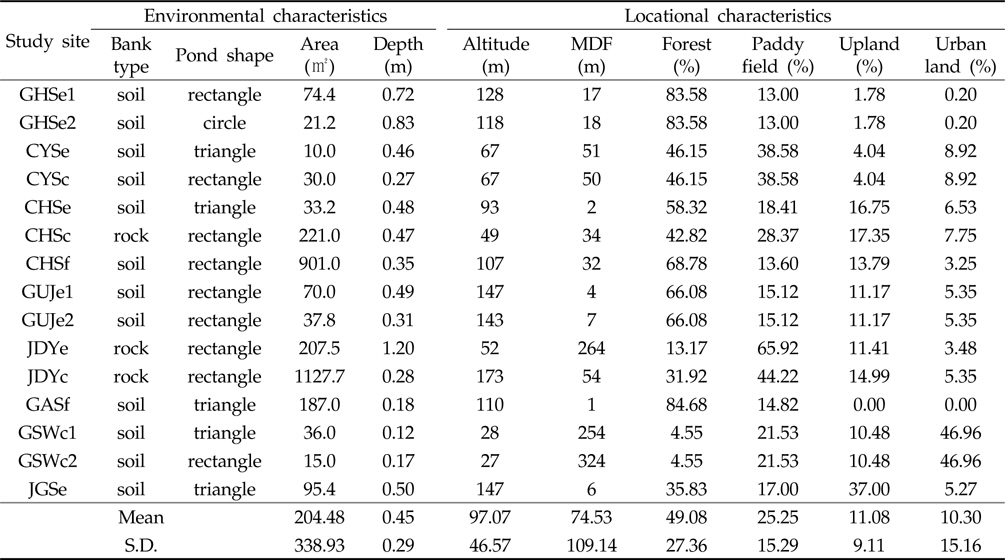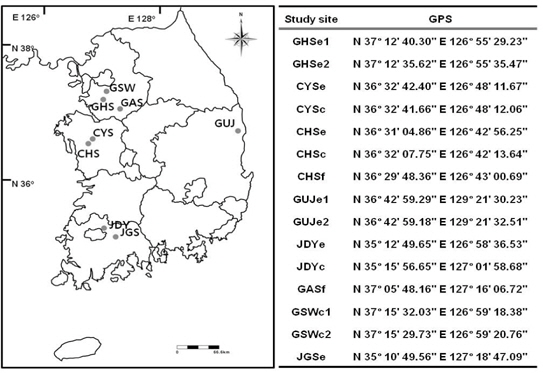



Ecological functions of irrigation ponds were well known fact that important for biodiversity conservation in agricultural ecosystems. However, many irrigation ponds were destructed with changes of agricultural environment. The objective of this study is to appreciate the importance of ecological functions of irrigation pond. Furthermore, it presented to useful information for restorations of irrigation pond from analyses of correlations between benthic macroinvertebrate communities and locational factors of irrigation ponds.
Benthic macroinvertebrate sampling was conducted from 2010 to 2012 at 15 study ponds. Comparisons of benthic macroinvertebrates diversity approached species richness and density, and statistical analyses were performed using independent t-test. A total of 131 species / 137,118 individuals of benthic macroinvertebrates were recorded during study period. Dominant taxa of benthic macroinvertebrates included Coleoptera, Hemiptera, and Odonata. Generally, benthic macroinvertebrate diversity in mountain region and existing ponds were showed higher than open field and created ponds, respectively. DCA ordination showed that benthic macroinvertebrate community was most correlated with locational characteristics of irrigation pond, and it correlated with bank type and age of pond.
In conclusions, in order to restore ecological irrigation pond, it is necessary to consider environmental factors such as locational characteristics and bank types.
논 농사가 주로 이루어진 우리나라에서 아주 빈번하게 나타난 습지의 한 유형이 둠벙이다. 둠벙이란 논에 이용하기 위해 물을 가두어 놓는 역할을 하는 소택형습지로, 물 저장과 장마철 홍수 조절 측면에서 중요한 기능을 한다(Kim
농업환경은 최근 각종 개발사업으로 인해 과거와는 다른 특성을 보인다. 농업환경 개선을 위한 다목적농촌용수 개발사업, 경지정리사업, 배수개선사업 등이 이루어져 논에 필요한 물의 공급은 과거에 비해 훨씬 수월해졌다. 이처럼 논의 용수공급 문제가 해결되면서 둠벙의 필요성은 감소하였고, 현재 논 생태계에서 둠벙은 과거에 비해 급감한 실정이다(Kim
최근 농업은 농약과 비료를 사용하던 관행농업으로부터, 토양의 지력과 천적생물 등을 적절히 이용하는 친환경농업의 비중이 점차 높아지고 있다(Han
저서성 대형무척추동물은 수서생태계의 생물 군집 가운데 가장 널리 연구된 생물 군집으로, 어류를 포함한 다양한 포식자에게 먹이원으로 중요한 생태적 지위를 지니고 있다(Pennak, 1989; Yoon, 1995). 저서성 대형무척추동물 군집은 주로 환형동물문(Annelida), 연체동물문(Mollusca), 절지동물문(Arthropoda)으로 구성되며, 절지동물 가운데 특히 하루살이목(Ephemeroptera), 잠자리목(Odonata), 노린재목(Hemiptera), 딱정벌레목(Coleoptera), 파리목(Diptera) 등의 수서곤충 무리가 대부분을 차지하는 것으로 알려져 있다(McCafferty, 1983). 저서성 대형무척추동물은 농업생태계내에서도 중요한 지위를 지니는 것으로 알려져 있다(Han
특히 논 생태계 내 생물다양성 증진을 위한 둠벙 복원에 있어 중요한 둠벙의 환경적 특성 및 입지조건과 저서성 대형무척추동물 군집조성의 상관성에 대한 연구는 아직 이루어지지 않았다. 근래 둠벙의 생태적 기능을 인정하고 논 생태계 생물다양성 증진 방안으로 지자체를 중심으로 한 둠벙 조성 사업이 이루어지고 있어, 이에 대한 연구의 필요성이 부각되고 있다. 따라서 본 연구에서는 논 생태계 내 둠벙에 서식하는 저서성 대형무척추동물의 분포 특성을 파악하여, 둠벙의 생태적 기능의 중요성을 입증하고자 하였다. 또한 둠벙의 환경적 특성 및 입지조건과 저서성 대형무척추동물 군집조성의 관계를 분석하여 둠벙 복원의 기초자료를 제공하고자 하였다.
본 연구의 조사는 8지역에서 총 15개 둠벙을 대상으로 실시하였다(Fig. 1, Table 1). 경기도 화성(GHS)에서 2개, 경기도 수원(GSW)에서 2개, 경기도 안성(GAS)에서 1개, 충청남도 예산(CYS)에서 2개, 충청남도 홍성(CHS)에서 3개, 경상남도 울진(GUJ)에서 2개, 전라남도 담양(JDY)에서 2개, 전라남도 곡성(JGS)에서 1개의 둠벙을 선정하였다. 경기도 안성과 홍성의 조사지점 중 CHSf와 GASf는 논의 가장자리 일부분을 담수휴경 한 곳으로 둠벙과 유사한 기능을 하기 때문에 조사지점에 포함하였다.

List of environmental characteristics and locational characteristics in survey irrigation ponds
야외조사는 2010년부터 2012년까지 각 둠벙에서 연간 2-4회 수행하였다. 저서성 대형무척추동물의 채집은 뜰채(망목 0.1mm, 내부 지름 27cm)를 사용하였으며, 한 지점 당 동일한 연구자가 미소서식처를 10분씩 3반복 채집하였다. 정량자료는 지점 당 3반복한 결과를 종합하여 단위 노력 (Catch Per Unit Effort) 당 채집된 저서성 대형무척추동물의 개체수(개체수/CPUE)를 단위로 이용하였다. 둠벙의 다른 생물적 요인을 파악하기 위한 어류 및 양서류의 채집도 병행하였으며, 저서성 대형무척추동물 정량채집과 동일한 방법과 단위를 이용하였다. 채집한 샘플은 아이스박스에 보관 후 실험실로 이동하였으며, 저서성 대형무척추동물을 골라낸 후 70% 에탄올에 고정하여 영구보존하였다. 골라낸 표본은 해부현미경 (Leica DE/MZ 7.5)을 이용하여 동정하였다(Yoon
본 논문에서는 둠벙의 입지적 특성 및 조성 후 경과시간(조성기간)에 따른 저서성 대형무척추동물의 다양성 비교에 초점을 맞추어 둠벙을 구분하였다. 둠벙의 유형 분류에 대한 문헌조사 결과, Kim 등(2011)에 의해 서부 민간인 통제구역의 둠벙 48개를 수문학 및 지형적 측면에서 구분한 연구가 이루어졌으나, 둠벙의 수문학적 측면에서 분류 기준을 제시하여 본 연구에 적용하기에는 부적합하였다. 따라서 본 연구에 적합한 둠벙의 새로운 분류 기준이 필요하여, 둠벙의 입지적 특성 및 조성 후 경과시간에 따른 별도의 기준에 의해 둠벙을 구분하였다. 본 연구에서는 둠벙의 입지적 특성에 따른 비교를 위해 조사된 모든 둠벙을 반경 0.5 Km 이내 산림비율이 50% 미만인 지역은 평야지대 둠벙으로, 50% 이상인 지역은 산간지대 둠벙으로 각각 구분하였다.
조성 후 경과시간에 따른 차이는 충남 예산(CYS), 충남 홍성(CHS), 전남 담양(JDY) 지역에서 조성 후 경과 시간이 5년이 초과된 둠벙(이하 기존둠벙)과 5년 이하의 둠벙(이하 조성둠벙)을 각각 비교하였다. 선행 연구에서 새롭게 조성된 연못에서 저서성 대형무척추동물의 종의 유입은 조성 후 4년째 부터는 비교적 유사한 종수를 유지하는 것으로 나타났으며, 3년 미만의 연못과 10년 이상의 연못은 종다양성 측면에서 뚜렷한 차이가 있는 것으로 연구된 바 있다(Williams
각 둠벙의 저서성 대형무척추동물의 다양성은 출현종수(이하 종 다양도) 및 개체수(이하 밀도)를 이용하여 분석하였다. 또한 둠벙 내 저서성 대형무척추동물 군집의 분포 특성을 파악하기 위하여 분류군 및 기능군 측면(섭식기능군, 서식기능군)의 분석도 실시하였다. 저서성 대형무척추동물의 분류군은 문(Phylum) 단위로 구분하였다. 단, 절지동물문의 경우 강(Class) 단위로 갑각강과 곤충강으로 세분하였으며, 특히 곤충강의 경우 목(Order) 수준에서 생태적 특성이 크게 다르므로 다시 목 단위로 세분화 하였다. 서식기능군(Habitat Oriented Groups, HOGs)은 지치는무리(Skaters), 헤엄치는무리(Swimmers), 떠있는무리(Planktoners), 기는무리(Sprawlers), 기어오르는 무리(Climbers), 굴파는무리(Burrowers)로 구분하였으며, 섭식기능군(Functional Feeding Groups, FFGs)은 썰어먹는무리(Shredders), 주워먹는무리(Gathering-collectors), 걸러먹는무리(Filtering-collectors), 식물뚫는무리(Plant-piercers), 잡아먹는무리(Predators)로 구분하였다(Merritt
저서성 대형무척추동물의 군집조성과 둠벙의 환경적 특성 및 입지조건 사이의 상관관계 분석을 위한 둠벙의 자료로 총 10가지 항목을 조사하였다. 둠벙의 환경적 특성에 대한 분석은 둠벙의 둑 유형, 둠벙 형태, 면적, 평균수심, 입지조건에 대한 분석은 고도, 인근 숲과의 최단거리(Minimum Distance from Forest, MDF), 산림비율(%), 논비율(%), 밭비율(%), 시가지비율(%) 측면에서 분석하였다.
둠벙의 환경적 특성 및 입지조건에 따른 저서성 대형무척추동물의 군집조성 특성은 DCA (Detrended Correspondence Analysis) 서열법으로 분석하였으며, 두 그룹의 유의성은 MRPP (Multiple Responses Permutation Procedure) 기법으로 검증하였다. 각 둠벙의 저서성 대형무척추동물 군집에 대한 유사도 분석은 Cluster analysis 기법을 이용하였다. 서열법 분석 및 유사도 분석은 PC-ORD program ver. 6 (McCune and Grace, 2002)을 이용하였다.
입지적 특성, 조성 후 경과시간에 따른 다양성에 대한 통계 분석은 각 그룹 간 independent t-test를 이용하였다. 저서성 대형무척추동물의 밀도는 자료의 정규화를 위하여 로그 변환 후 통계분석 하였다. 모든 통계분석은 SAS program ver. 9.2를 사용하였으며, 입지조건 가운데 토지이용도의 경우 ArcGIS program ver. 10.0을 이용하여 분석하였다.


